I have some seed of "Korean Violet" identified as Viola koreana 'Syletta', but have also seen it listed as Viola gyproceras var. exilis . Can anyone tell me which one is the current correct name for the plant?
Comments
Viola species - confusing latin names
I use three sites for checking plant names:
Tropicos (The Plant List uses information from this site), gives a trail of synonymy.
http://www.tropicos.org/Home.aspx
The Plant List - can be controversial, lots of omissions and lots of taxa listed as "unresolved", lots of synonym missing. Yet still extremely useful, a single source to referee on current taxonomic status and acceptance of names.
http://www.theplantlist.org/
The International Plant Names Index (IPNI). I typically go here first, because it can quickly be searched and displays all published plant names. In the case of this violet, I searched Viola for genus and used a "wild card" for species, thus entered g* and it gives me a list of all Viola species that start with the letter "g"... looking through the list, I detect a misspelling at play, there is no "gypoceras", but there is a "grypoceras"
http://www.ipni.org/ipni/plantnamesearchpage.do
The IPNI.ORG site is typically extremely thorough, but subtaxa (ssp. and var.) are not always listed, so there are omissions. On the opposite side of things, there is GOOGLE, which I use constantly, but the internet is often responsible for spreading bad information, repeating misspellings and misidentifications ad infinitum.
There is no published name Viola koreana, so the first thing I checked to see, is there a Viola coreana, the "coreana" spelling of plants from Korea is more common than the alternate koreana, and the two get used interchangeably. And yes indeed, there is a Viola coreana, it can be found in all three sites listed.
But sometimes it is still best to have a good book, because in this case, the digital sites still don't show the synonymy trail, and I can't find Viola grypoceras var. exilis. I do find Viola exilis, a synonym of V. volcanica, one of the South American rosulate violets, a dead-end because our subject Viola grypoceras is an Asian species. So, I pull out my 1000+ page Flora of Japan. Under Viola grypoceras, there's a raft of synonyms + 5 subtaxa described, including V. grypoceras var. exilis (Miq.) Nakai., with two synonyms listed: V. sylvestris var. exilis and V. coreana. Aha! the synonymy trail is now complete. Well, it should also be noted that Flora of Japan by Ohwi was published in the 1950s (my copy is a republish from the 1980s), and many of the subtaxa described have now been put into synonymy with primary species, such that, V. grypoceras var. exilis is not recognized, it is just V. grypoceras.
One further clue, I google searched Viola grypoceras Flora of China, which takes me to an entry for this species in the awesome online Flora of China site. Lots of synonyms of this Viola species, Viola taxonomy is very complex. At the very bottom of the species description, there is a note: "One of us (Ohba) prefers to treat plants with stems nearly procumbent or creeping as Viola grypoceras var. exilis (Miquel) Nakai.", so perhaps that name can be used after all. This species is actually found in Japan, Korea, and China, perhaps accounting for taxonomic confusion when species are first published in separate regional floras.
http://www.efloras.org/florataxon.aspx?flora_id=2&taxon_id=200014364
Last item, the species itself is not normally a variegated leaf plant, so the delightful little plant with silvery leaf variegation is a selection and needs a cultivar name associated with it, thus it typically goes around as Viola grypoceras exilis 'Sylettas' or 'Syletta', the epithet referring to a person's or family's surname.
http://www.perennials.com/plants/viola-grypoceras-exilis-sylettas.html
Phew, I'm tired after all that ;)
Viola species - confusing latin names
Yeah, that's what I thought...................I think!
Viola species - confusing latin names
Here's the plant in question, a tiny little violet about 1" tall, if that. Here it is blooming in mid April.
Viola species - confusing latin names
A fascinating and most useful read. Thank you. 8)
Re: Latin Names?
Thank you, Mark, for uncovering the true tale of this little plant. Had no clue that my innocent question would open up such a can of worms! I'll try to do additional hunting on the web before asking about other species. Now I can plant some seed of Viola grypoceras exilis 'Syletta' in confidence. Cheers!
Viola species - confusing latin names
My pleasure Gordon, I've been through this research a few times, figured I might as well document it here so that I don't have to remember it again. Here's a photo of this violet in late September 2012, co-mingling with Cyclamen purpurascens, the fancy leaf cyclamen coexisting peacefully with the variegated Viola grypoceras var. exilis 'Syletta'. The violet has the lighter green and white striped leaves.
Viola species - confusing latin names
Should have looked in there first, Viola g.var e is mentioned in the AGS Encyclopaedia of Alpines. V coreana is given as a synonym.
Viola species - confusing latin names
Mark, thank you for sorting out the nomenclature. I, too, have wondered about the proper name of this violet, and it's great to have a definitive answer.
Given that violets are often sold and passed along under the wrong species name, how confident are you that the violet in your photo is V. grypoceras, as opposed to, say, V. selkirkii var. variegata? V. grypoceras is a stemmed violet, and the plant in your first photo looks pretty darn acaulescent. More subjectively, the plants I've seen under the name V. grypoceras (or synonyms) tend to have leaves with a very dark green background and blunt, not acute, tips.
Fortunately, both V. grypoceras and V. selkirkii are in Flora of China online, so it's possible to key out the plant -- assuming it is actually one of these two.
Viola species - confusing latin names
Interesting discussion.
What I have as Viola grypoceras var. exilis 'Sylettas' does have a different leaf shape, perhaps like Janet is describing.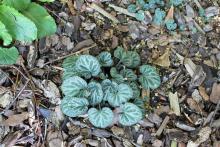
Edit to add: Unfortunately, I don't get to see a lot of blooms on these plants, though they are seeding around nicely. It seems to be mostly cleistogamous.
Viola species - confusing latin names
Hello Janet,
First of all, welcome to NARGS Forum! Coincidentally, a similar discussion on this violet is going on in a FaceBook plant group. You bring up good points; I might need to draw a flow chart to make all of this clear ;)
There do appear to be two variegated violets in question, both from Japan (most likely Korea and China too). The one I show above, has light green cordate to deltoid shaped leaves. A second variegated violet has thicker reniform (rounded) leaves, that are purplish on the back. Any and all names have been applied to both. It's also been said that the two will hybridize and create all sorts of leaf forms.
Leaf shape reference: http://www.merriam-webster.com/art/dict/leaf.htm
So, there are two cultivar names for variegated violet kicking around, the aforementioned 'Syletta', and another one named Viola 'Silvia Hart', once sold by Siskiyou Rare Plant Nursery, and still available commercially. Usually there is no species attribution, but sometimes it is listed as V. selkirkii 'Silvia Hart'. I believe the discussion comes down to 3 species, V. grypoceras, V. selkirkii, and V. variegata. We can toss out V. coreana / koreana right here and now, because it is not a valid species. Let's look at the three species:
Viola selkirkii:
Drawing and description of Viola selkirkii, Flora of China
This species is circumpolar (northern hemisphere)
http://www.efloras.org/object_page.aspx?object_id=94288&flora_id=2
http://www.efloras.org/florataxon.aspx?flora_id=2&taxon_id=200014422
...this species occurs in North America too:
http://plants.usda.gov/java/profile?symbol=VISE2
http://wisplants.uwsp.edu/scripts/detail.asp?SpCode=VIOSEL
http://wisplants.uwsp.edu/scripts/bigphoto.asp?bigphoto=VIOSEL_RWF.jpg&t...
One of the synonyms of Viola selkirkii is Viola selkirkii var. variegata Nakai. This should not be confused with an accepted species, Viola variegata Fisch., I'll get to that one later.
***I think we can eliminate V. selkirkii in this assessment, I do not believe it is related to either of the two variegated violets in question.
Viola grypoceras:
You are correct to point out the taller stems of Viola grypoceras, the drawing clearly shows that:
Drawing and description in FOC
http://www.efloras.org/object_page.aspx?object_id=94264&flora_id=2
http://www.efloras.org/florataxon.aspx?flora_id=2&taxon_id=200014364
Viola grypoceras var. exilis (Miquel) Nakai
However, at the bottom of that species description in Flora of China, it is written "One of us (Ohba) prefers to treat plants with stems nearly procumbent or creeping as Viola grypoceras var. exilis (Miquel) Nakai". Aha! In Ohwi's Flora of Japan, the description of Viola grypoceras var. exilis is "smaller plant with decumbent stems and depressedly deltoid leaves, truncate at the base"
The hairy branched stipules, seen in the drawing of V. grypoceras, should be able to help us validate the Viola species once back in growth this year. I'm sticking with this ID for the time being.
Viola variegata:
Drawing and description in FOC:
http://www.efloras.org/florataxon.aspx?flora_id=2&taxon_id=200014442
http://www.efloras.org/object_page.aspx?object_id=94297&flora_id=2
This species has short leaf petioles, leaves thick membranous, broadly ovate to orbicular, often white variegated on upper surface, purplish beneath, and obtusely toothed, describes the so-called "cyclamen leaf" violet to a tee. Second aha moment, the plant going around as V. koreana (name of no botanical standing) is actually V. variegata. But don't forget, the pointy-leaf variegated violet also goes around under V. koreana and a bunch of other names.
Summary:
1. Light green pointy-leaf variagated violet is Viola grypoceras var. exilis.
2. Dark green round-leaf variegated violet is Viola variegata.
Viola species - confusing latin names
Lori, good photo of that plant. I do think these 2 different variegated violets are terribly mixed up in horticulture and names used interchangeably. Also, one person in a FaceBook plant group mentioned having both, hard to keep them separate as they hybridize easily.
Re: Latin Names?
Mark, thank you! Just as your message appeared, I had be coming to the conclusion myself that the dark-leaved violets couldn't be V. grypoceras. I agree that the Viola variegata description is an excellent match for the dark-leaved plants. Come spring, I'll be taking that Flora of China description and giving my plants a thorough interrogation.
I'm not entirely convinced that Viola grypoceras is the correct species for the pale-leaved violet. In photos and in my memory, the pale-leaved plant is acaulescent, whereas V. grypoceras has stems that are 5-20 cm when the plant is in bloom. Even if the stems are decumbent, the plant should still be clearly distinguishable from an acaulescent plant. On the other hand, it's been several years since I've grown the pale-leaved violet, and maybe I never looked at it carefully enough. And maybe there's more than one pale-leaved variegated violet wandering through our gardens. Violets are such a vexing mess delightful challenge!
Viola species - confusing latin names
I agree Janet, violets are such a vexing mess delightful challenge! ;) :D
Yes, I too will give a more discerning look at my plants this year. As I recall, the stems do extend horizontally along the ground for some small distance, thus not totally acaulescent, but I'll need to confirm that, could be my memory playing tricks on me again :)
Plants in hort might also be of hybrid origin. I think of this when I look through one of my two treasured out of print books: "Some Natural Violet Hybrids of North America" by Ezra Brainerd, 205 pages, published in 1924, where it is documented that almost every North America violet species readily hybrids with just about every other species.
Viola species - confusing latin names
This has been a real education about Viola taxonomy. Just for the record, the seed I just planted came to me from Jelitto under the name Viola coreana 'Syletta'. I'll have to examine the plants once they get large enough!
Viola species - confusing latin names
Mark, let us know if you reach a conclusion on the violet ID.
Viola species - confusing latin names
Mark, let us know if you reach a conclusion on the violet ID.
Will try to remember, but it won't be for another 3 months or more. :)
I must say, the sleuthing done so far is just following the synonymy trail. Who know if the plant going under any of these names has any basis whatsoever with any of the names given to them. Here's a very nice site showing Japanese violet species, each pic enlarges to a large clear photo, there are a number of variegated types, as well as some botanical names that are considered invalid, but they're all lovely little creatures. I would like to grow more of these, enjoy:
http://danwiz.com/Violets/Violets.php
There is also a PDF that can be downloaded, a partial photographic essay on japanese Viola species, the photos are high quality. The PDF is a little over 3 MB in size.
http://danwiz.com/Pubs/Violets8.5x8.5_Sample.pdf
Oh by the way, unless any objection, I plan on renaming this topic to one devoted to Viola species.
Viola species - confusing latin names
Oh by the way, unless any objection, I plan on renaming this topic to one devoted to Viola species.
Sounds like a good idea Mark.
Now just to add to the discussion ;D here's what i raised from seed many moons ago as Viola selkirkii ......
Cheers Dave
Viola species - confusing latin names
Nice one Dave. The more I look at these, the more confusing the whole thing gets. Seems like many Viola species have a variegate form. Just found this on a Japanese site, 4th image down is listed as Viola selkirkii f. vareigata:
http://homepage2.nifty.com/ga-hanatozan/ga-hanatozan/p-114apoi-sindou/ap...
Viola species - confusing latin names
I assumed all V selkirkii was variegated as I have never seen any all green ones ;) I have tried V. selkirkii and "koreana" several times from seed and been lucky a couple occasions but the plants are always damaged by slugs :-\
These all look nice- Violas
These all look nice- Violas and variegates- what's not to like?
Did everyone get their plants figured out during the season?
cohan wrote:
[quote=cohan]
These all look nice- Violas and variegates- what's not to like?
Did everyone get their plants figured out during the season?
[/quote]
Sometimes ignorance is bliss , the more I look the more I wonder. On the internet (particularly on Japanese sites) there's a surprising number of look-alike species with variegated forms. The mystery of my two violets can wait for another year.
, the more I look the more I wonder. On the internet (particularly on Japanese sites) there's a surprising number of look-alike species with variegated forms. The mystery of my two violets can wait for another year.
After reading through this
After reading through this discussion, I figure that my plants are actually Viola variegata. The plants appear to be cleistogamous as Lori noted earlier in the discussion. I notice seed pods, but never a single bloom. Would high ambient temperatures play a role in this? The seedlings have been growing all summer in our greenhouse, so they have experienced higher than normal temperature and light levels for the full season. Now that the plants are large enough, they are being moved into permanent locations in the landscape. Next year will tell me if the cleistogamy is permanent, or due to cultural conditions.
Thanks for the education about these gems!
I think no flowers for a
I think no flowers for a violet would be very disappointing! Though these do have lovely foliage to make up for it... I have a Saussurea received as nepalensis which has made tons of flowers that never opened, but produced seed (is cleistogamous still the right term for Asteraceae) and the foliage is not that exciting...lol
Mark McD wrote:
[quote=Mark McD]
Sometimes ignorance is bliss , the more I look the more I wonder. On the internet (particularly on Japanese sites) there's a surprising number of look-alike species with variegated forms. The mystery of my two violets can wait for another year.
, the more I look the more I wonder. On the internet (particularly on Japanese sites) there's a surprising number of look-alike species with variegated forms. The mystery of my two violets can wait for another year.
[/quote]
I can relate- I grow a lot of cacti and succulents indoors, and there are some popular genera that are huge with highly variable species, plus issues of hybridisation in culture- in many cases I've decided that if they don't come with provenance and reliable names, they will remain forever nameless..

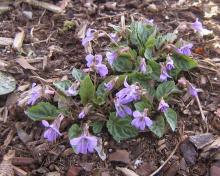
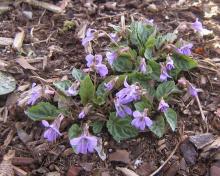
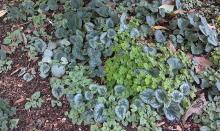
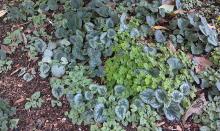

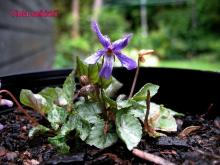
Fascinating. V. koreana is not even mentioned in the Plant List (http://www.theplantlist.org/) which is my usual port of call for names. Nor is V. gyproceras var exilis. The Plant Finder refers V. koreana to V gypoceras var. exilis so I guess that is the current name for it, but.................................